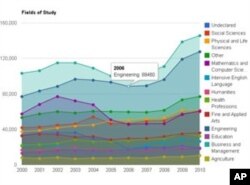U.S. colleges and universities have seen a tremendous increase in international students studying business and engineering in recent years.
Evidence suggests the two fields' overwhelming popularity is driven by students' views of which U.S. programs will offer them the best preparation for a good job.
About 40 percent of the nearly 700,000 international students in the United States last school year were in either business and management or engineering, according to the latest statistics from the Institute of International Education. Business has topped the fields of study list in the IIE's Open Doors report for the past decade, with engineering a close second.
Peggy Blumenthal, the organization's executive vice president and chief operating officer, says the high numbers of students from China and India, the top two sending countries, greatly influence the overall results.
"The growing economies of India and China provide strong employment opportunities for students trained in the U.S. in these two fields," she said. "So they will see an immediate return on their investment in a U.S. degree."
Opportunities Attract
Jinesh Shah, a senior business manager at the U.S. bank, Capital One, knows firsthand how valuable a U.S. degree can be for foreign business and engineering students. Originally from India, Shah came to the U.S. nine years ago to get his master's degree in industrial engineering from the University of Florida.
"The public university system in the U.S. is a lot more advanced than at least I've seen in most other places, including India, Australia and the UK," he said. "The way research happens here in a university is much more sophisticated and advanced. So [in] fields like engineering, be it aerodynamic, computer or anything else, the research that happens is real-life research with company sponsoring."
Shah said the research experience provided in the U.S. gives students "an edge" that separates them from other applicants when they enter the corporate world.
The attractiveness of research opportunities to foreign students becomes even more apparent when you look at which universities enroll the most international students. Nineteen of the top 25 hosting schools named in this year's Open Doors report were ranked in 2009 as top American research universities by The Center for Measuring University Performance.
The University of Illinois at Urbana-Champaign is one of them. With nearly 7,300 international students last school year, the university hosts the second highest number of foreign students of any U.S. institution after the University of Southern California, according to data from the IIE.
Julie Misa, the director of International Student and Scholar Services at the Illinois school, says research is one of the main reasons that nearly 40 percent of the international students at UIUC are pursuing engineering.
She said engineering students in the U.S. often get the chance to practice in their field at "state-of-the-art labs and with cutting-edge technologies."
Misa said opportunities and rankings also play a role on the business side.
"The U.S. is such a presence in the business world internationally," she noted, "and English is an important language in business, the international language, so coming here to study makes a lot of sense from that perspective."
The popularity of business studies is further proven by the fact that schools drawing the most international students often have top business schools. U.S. News & World Report named 24 of the 25 top hosting schools last school year to its 2010 rankings of the 100 best business schools in the United States. Twenty-three of them cracked the top 50.
Money Matters
Misa says affordability is another important factor in foreign students' perception of the value of a U.S. education. Both the state of the economy in a person's home country and a family's personal financial situation are important.
Capital One manager Shah says cost is likely one of the reasons behind the comparatively low and declining numbers of international students in health fields.
This year's Open Doors data showed a nearly 8.5 percent drop in the 2009-2010 school year in international students pursuing health professions. A little more than 32,100, or less than 5 percent of international students, were recorded in health fields. That was just a quarter of the students studying engineering.
Shah -- whose wife is a physical therapist in the U.S. and also from India -- points out that in many cases, pursuing health fields in the U.S. will not only cost students more money than programs in other countries, but also more time.
"If I compare how much schooling you have to do to get a health care degree and how much it costs, it's just astronomical, at least in my mind, as compared to any of the countries that I know of in Asia," he said. "When you look at a cost-benefit analysis of, is this degree worth [it]? -- I think the regular health care fields do not stand up to that test. So, unless it's a very specialized field, an advanced degree or some sort of fellowship, it's very hard to see just for a regular health care degree why [there] would be many students."
Shah's wife, Pallavi, who got her master's degree in physical therapy in Scotland, agrees with her husband. When asked what might be deterring students from studying health professions in the U.S., she said, "It's expensive." Pallavi said she has seen many people opting instead to get their education elsewhere and then come to the U.S. to practice.
Blumenthal says the health sciences field does not provide as much support for graduate students from abroad as other science and technology fields.
Tight restrictions can also make it more difficult for international students to get a U.S. education in health. Many medical schools do not accept international applicants, and those that do sometimes have strict requirements, like putting up to four years' worth of tuition and fees (some $200,000 or more) into an account before enrolling.
Blumenthal said the health sciences field also does not offer as many subfields as social sciences or physical and life sciences.






